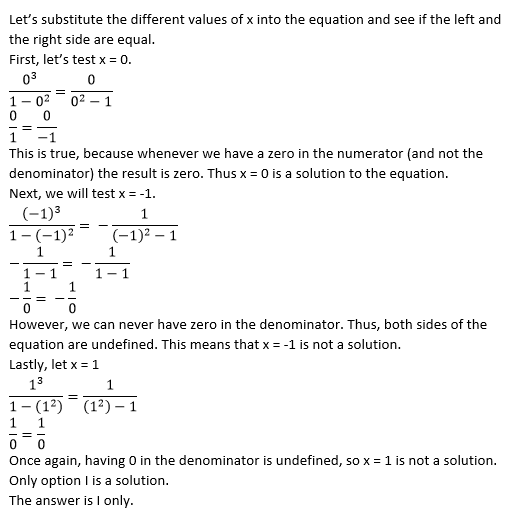All PSAT Math Resources
Example Questions
Example Question #1 : How To Find The Solution To An Inequality With Division
Solve the inequality
First, multiplying each side of the equality by 




Example Question #41 : Inequalities
What is the solution set of the inequality 
We simplify this inequality similarly to how we would simplify an equation
Thus
Example Question #11 : How To Find The Solution To An Inequality With Division
What is a solution set of the inequality 
In order to find the solution set, we solve 
Therefore, the solution set is any value of 
Example Question #71 : Equations / Inequalities
Find the solution to the following equation if x = 3:
y = (4x2 - 2)/(9 - x2)
6
0
3
no possible solution
no possible solution
Substituting 3 in for x, you will get 0 in the denominator of the fraction. It is not possible to have 0 be the denominator for a fraction so there is no possible solution to this equation.
Example Question #2 : How To Find Out When An Equation Has No Solution
I. x = 0
II. x = –1
III. x = 1
I only
II only
I, II, and III
III only
II and III only
I only
Example Question #2 : Linear / Rational / Variable Equations
There is no solution
1
–3
3
–1/2
There is no solution
Example Question #2 : How To Find Out When An Equation Has No Solution

None of the other answers
A fraction is considered undefined when the denominator equals 0. Set the denominator equal to zero and solve for the variable.
Example Question #1 : Linear / Rational / Variable Equations
Consider the equation
Which of the following is true?
The equation has no solution.
The equation has exactly one solution, which is positive.
The equation has exactly one solution, which is negative.
The equation has exactly two solutions, which are of like sign.
The equation has exactly two solutions, which are of unlike sign.
The equation has exactly two solutions, which are of unlike sign.
Multiply the equation on both sides by LCM 
or
Substitution confirms that these are the solutions.
There are two solutions of unlike sign.
Example Question #822 : Psat Mathematics
Which of the following equations has no solution?
Each of the equations in the other responses has no solution.
Each of the equations in the other responses has no solution.
The problem is basically asking for what value of 
has no solution.
We can simplify as folllows:
Since the absolute value of a number must be nonnegative, regardless of the value of 
Example Question #1 : Linear / Rational / Variable Equations
Consider the equation
Which of the following is true?
The equation has exacty one real solution, which is negative.
The equation has exacty one real solution, which is positive.
The equation has no real solutions.
The equation has exactly two real solutions, which are of like sign.
The equation has exactly two real solutions, which are of unlike sign.
The equation has exactly two real solutions, which are of unlike sign.
Multiply both sides by LCD 
or
There are two solutions of unlike sign.
All PSAT Math Resources





































































